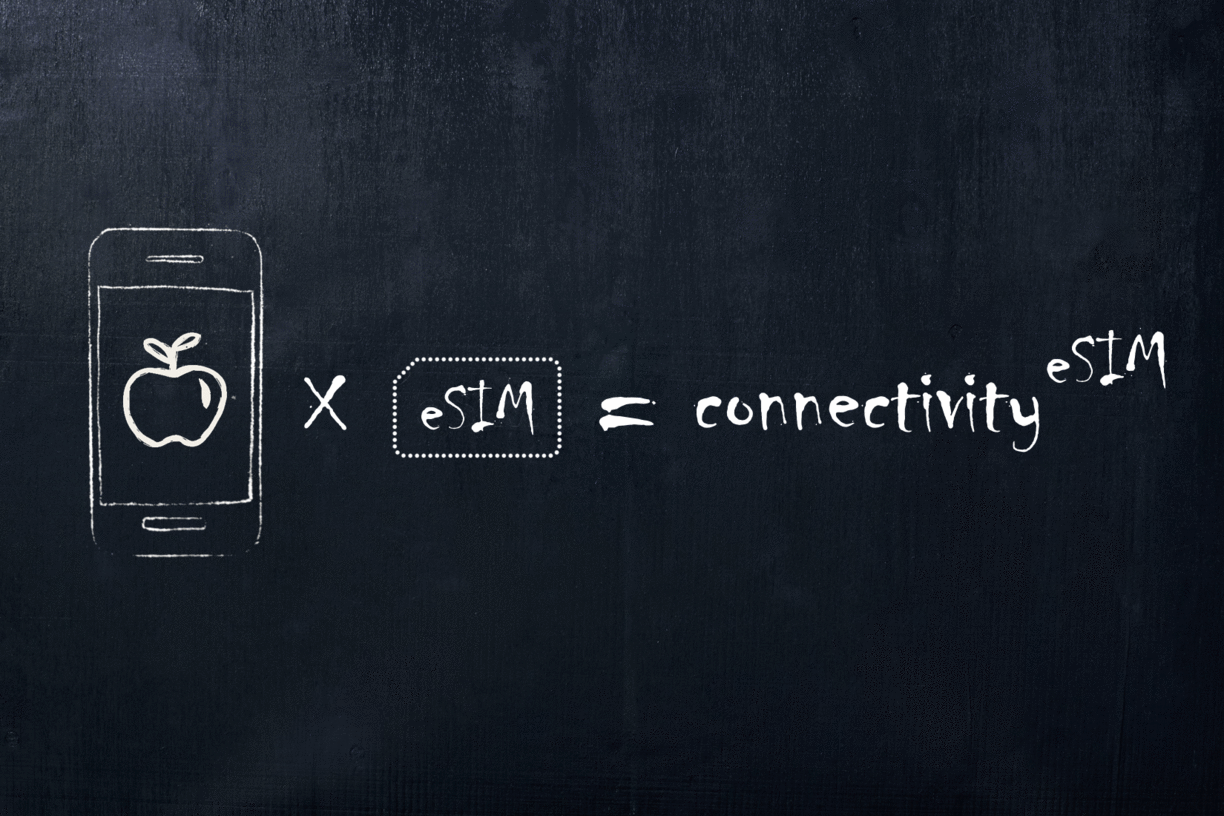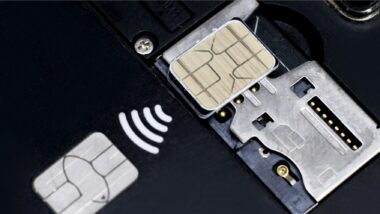
< 4-minute read
September 12, 2018 is a date that has marked the eSIM industry forever: that particular day, Apple announced that its newest iPhones (iPhone XS, iPhone XS Max, iPhone XR) would ship with eSIM technology. The new iPhones became the first widely marketed eSIM-compatible smartphones ever launched. Thus, generating a wind of change onto the mobile and eSIM/SIM card industries.
-
Bringing eSIM to the masses
At the time of this world’s first, Apple was -still- is the world’s number 2 smartphone vendor (after Samsung which holds 20% of the worldwide market).
With almost 1.93 billion iPhone sold worldwide between 2007 and 2019, Apple’s flagship smartphone revolutionised the mobile industry with pioneering features that were quickly adopted by competitors, such as full screen phones, fingerprint authentication and the creation of the App economy. As a trend setter, it represents the reference point for innovation and whenever new features launch, customers have quickly learned what they are, and how they work.
That’s why Apple’s eSIM adoption is a true game changer. It will further increase eSIM awareness and adoption among consumers globally – in addition to the iPad Pro and iWatch’s current support of eSIMs.
In terms of customer experience benefits, eSIMs simplify the user journey thanks to the digitalisation of the mobile subscription activation of eSIM-ready devices.
eSIM-ready iPhones further increase eSIM awareness and adoption among end-users & consumer product OEMs globally
Apple has made it clear it would generalise eSIM across all its product portfolio. Fuelled by this strategic eSIM vision, all new iPhone models launched since September 2018 support eSIM (the iPhone 13 being the latest one, following its launch in October 2020).
-
Democratizing mobile access among OEMs and ODMs
Apple’s eSIM endorsement is a fantastic spotlight for the SIM industry in bringing mobile-connectivity-as-a-feature for original equipment & device manufacturers.
It truly facilitates the pervasiveness of cellular technology into existing non-connected devices such as smartwatches, wristbands, PCs and new categories of devices including headphones, digital healthcare assistants, pet trackers, smart clothing, coffee machines and many other consumer devices.
Thanks to mobile connectivity miniaturization, innovation in device features is enhanced. This means customers can now enjoy extended battery life, reduced thickness & weight in their devices, and improved waterproof capabilities (as the pop-out SIM tray will no longer exist for some secondary devices such as wearables, and even for some smartphones, e.g. motorola razr is the first mass-market eSIM-only smartphone).
How does the world’s most popular mobile OS, Google’s Android, envision eSIM?
At the end of 2018, Google announced Android eSIM support for all OEMs. With its leaked Hermes project, Google wishes to add this functionality to Chrome by delivering messages between devices with eSIM chips and carrier servers through profile downloads as well as service discovery for new carriers. It aims to provide seamless integration with Project Fi and an easily portable API to be used on different hardware.
Announced in October 2018, Google’s Pixel 3 and Google Pixel 3 XL smartphones include eSIM technology in addition to a nano-SIM. Compared to the Pixel 2 – which already supports eSIM, but intentionally locked to only work with Google’s own Project Fi, these new models will also work with eSIM-open mobile operators like Verizon, T-Mobile, AT&T to name just a few.
As an aside, with so much connectivity around us, we’re now tantalizingly close to American writer Gary Shteyngart’s 2013 prediction that being unconnected is a luxury only the richest people will be able to afford.
-
Inflecting the SIM industry history
The SIM industry is at a turning point in its evolution: the commitment of a giant such as Apple is a positive growth signal for the eSIM technology market.
In its survey eSIM in the consumer market published in May 2018, ABI Research highlighted that eSIM support from major smartphone vendors such as Apple and Samsung would significantly stimulate massive adoption of eSIM in the consumer space. It also forecast that the switch to eSIM by the first mover would likely pave the way to attract other contenders such as China’s Huawei. After Apple’s keynote, ABI Research revised upwards its consumer eSIM shipment forecasts by 40% to reach more than half a billion units by 2022. Counterpoint forecasts that 60% of all mobile phones will support eSIM technology by 2025.
The future’s in the air
I can feel it everywhere
Blowing with the wind of change
Song: “Wind of change” – Scorpions, 1990
Logically any new device accepting an eSIM will contribute to increased market traction for SIM card vendors’ products & services, such as GSMA-compliant Remote SIM Provisioning eUICCs platforms. For example, Thales already provides more than 200 eSIM management solutions, making us the undisputed number 1 provider in eSIM solutions worldwide. Some of the next open questions are: When will the iPhone be eSIM-only? When will iPhones support iSIM (the integrated SIM, a new eSIM form factor built as a trusted area into a multi-function chip)?
-
Contributing to the digitalization of mobile operators’ user journey
The launch of eSIM-compliant iPhones has opened up a new era in the distribution model of mobile subscription and connectivity.
Apple’s new iPhone generation supports Dual SIM Dual Standby (DSDS) feature[1], including one eSIM and a removable nano SIM (except in China, with a dual nano SIM). In addition to inserting a removable SIM card in a drawer, users can add a new operator in seconds remotely through software. If eSIM and SIM subscriptions are locked onto the same operator for subsidized iPhones, it’s a different story for open market iPhones (i.e. the ones you buy separately from your mobile subscription): two different operators can seat in the same smartphone. It means a first mobile operator can offer its offer via the SIM card slot, and a second one via the eSIM. Paving the way for major competition between operators proposing aggressive offers.
The iPhone’s eSIM features are offered through an iOS software update. But only operators going through a stringent Apple certification process will be able to open up their iPhones with their offer.
After mobile operators have pushed to have eSIM carefully specified by GSMA’s trade body, it’s no surprise to see some of them now considering eSIM with precaution.
I fear what I hope
Book: “The pleasure” – By Italian novelist Gabriele d’Annunzio, 1889 (original quote in French: “Je crains ce que j’espère”)
But the good news is that ….
Mobile operators can fully embrace the full opportunities offered by the digitalization of the user journey. Many of them have already done so by offering connectivity bundles for adding multiple devices on a single contract, which can help with increasing the revenue per subscription.
This implies that there is a need to fully transform operators’ mobile connectivity lifecycle management policy to address the barriers hindering the massive adoption of consumer eSIM:
- Complex device & customer onboarding
- Multiple purchase channels
- Cumbersome subscription activation
- Limited customer lifecycle management
This is the first-time mobile operators face such a variety of end-user options. I’d be really interested to hear from mobile operators or OEM vendors and their view of the eSIM opportunity.
Have I missed anything important? If yes, I will update this blog and cite your comment (and send you a small gift via courier 😉 ). Let me know in the comments or by tweeting us @ThalesDigiSec.
Feel free to read my other blogs and infographics on eSIM here:
- 3 reasons why eSIM is ready to make an impact in consumer IoT and M2M markets
- eSIM simplified: a guide to consumer eSIM-ready device activation | Blog series (1/3)
- How Thales is staying at the forefront of eSIM innovation
- What the world’s first smartphones equipped with single-chip eSIM / embedded Secure element means for OEMs
- What’s an eSIM?
- What’s an iSIM (integrated SIM)?


